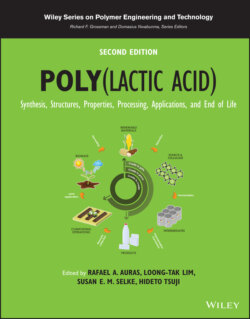Читать книгу Poly(lactic acid) - Группа авторов - Страница 64
3.2.2 Solid‐State Polycondensation
ОглавлениеThe disadvantage of the PLA prepared by direct polycondensation is often a limited molecular weight in combination with a low yield. Some progress in increasing the molecular weight of the PLA has recently been achieved, though, by sequential melt/solid polycondensation [5, 31].
In sequential melt/solid‐state polycondensation, the three first stages as described for direct polycondensation (i.e., removal of the free water content, oligomer polycondensation, and melt polycondensation) are utilized with an additional fourth stage. In the fourth stage, the melt‐polycondensated PLA is cooled below its melting temperature, often followed by particle formation as it solidifies. The solid particles are then subjected to a crystallization process, where two phases can be identified: a crystalline phase and an amorphous phase. It is believed that the reactive end groups, as well as the catalyst, are concentrated in the amorphous phase in between the crystals (Figure 3.3), thus yielding an apparent enhancement of the polycondensation rate although the polycondensation is performed in the solid state at a low temperature (i.e., below the melting temperature of the polymer). A metal catalyst can catalyze the solid‐state polycondensation in the amorphous phase, as well as the melt‐polycondensation. These catalysts can be different metals or metal salts, from metals such as Sn, Ti, and Zn.
FIGURE 3.3 Schematic description of the solid‐state polycondensation.
The rate‐determining step in solid‐state polycondensation is the mass transport of the reaction water by molecular diffusion. The removal of water can be further enhanced by carrying out the reaction under vacuum conditions in an inert atmosphere.
A process for preparing PLA by sequential melt/solid‐state polycondensation has been described [32]. The process comprises a liquid‐phase polycondensation reaction step, followed by a solidification and particle formation step of the prepolymer formed, by crystallization of the prepolymer particles, and finally a solid‐phase polymerization step. The weight‐average molecular weight of linear PLA obtained by this process was above 100,000 g/mol, which in many cases was a 10‐fold increase when compared with the prepolymer. The total process time to prepare the PLA was about 100 h, starting from 88% lactic acid. The weight‐average molecular weight was determined by GPC at 40°C in chloroform compared with polystyrene standards. A similar process for making poly(hydroxycarboxylic acid) was described where a low‐molecular‐weight polycondensate was pelletized and crystallized, and a solid‐phase polycondensation reaction step was performed by heating the pellets to a temperature not lower than the crystallization temperature [33]. According to the invention, pellets of poly(hydroxycarboxylic acid) of low molecular weight caused no blocking in the equipment, and it was possible to efficiently prepare poly(hydroxycarboxylic acid) of high molecular weight. The weight‐average molecular weight obtained by this process was in the range of 128,000–152,000 g/mol (GPC, 40°C, chloroform) requiring a minimum solid‐phase polycondensation reaction time of 40 h.
Stereoblock PLA was synthesized by solid‐state polycondensation of a 1:1 mixture of PLLA and PDLA [34]. In the first step, PLLA and PDLA having a medium molecular weight were melt polycondensated. The PLLA and PDLA were then melt blended in a 1 : 1 weight ratio to allow the formation of their stereocomplex, and the blend was subjected to solid‐state polycondensation. Some process optimization with regard to polymerization conditions was done and molecular weights exceeding 100,000 g/mol were obtained for the stereoblock PLA (GPC relative to poly(methyl methacrylate) (PMMA) standards with hexafluoroisopropanol (HFIP) as the eluent). In another study, it was found that the weight‐average molecular weight of the resultant stereoblock PLA was strongly influenced by the lactide/oligomer content in the melt blend, which is determined by the melt‐blending conditions because it is directly correlated with the crystallinity of the polycondensation products [35]. The effect of crystallization on the solid‐state polycondensation of PLLA has also been investigated [36]. The results showed that the M w of the PLA reached a maximum value when a crystallization time of 30 min (105°C) and solid‐state polycondensation of 35 h (135°C) were used.
